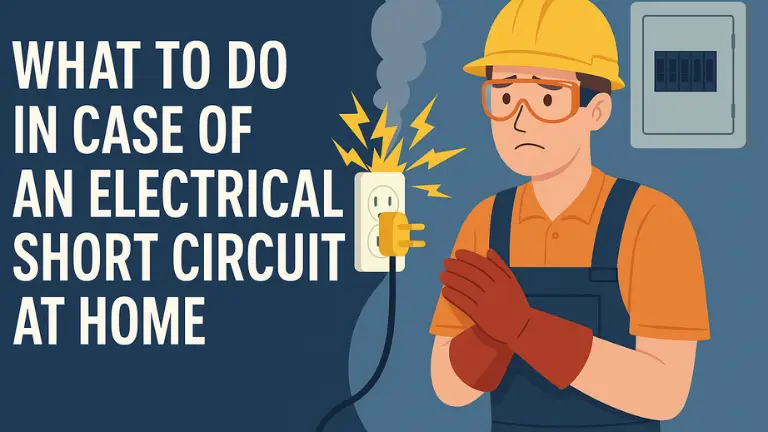
You turn on a light, and suddenly the room blinks, a loud sound pops, and the power goes off. Your heart beats fast. Is this a short circuit? Don’t worry. A short circuit can feel big, but simple steps keep your home safe. This guide shows you what to do when a short circuit happens, how to find it, and how to stop it from coming back. With the right electrical services, you can make your home safe and happy.
A short circuit is when electricity goes the wrong way. Usually, electricity moves through wires to light your bulbs or run your TV. If wires break or an outlet has a problem, electricity takes a quick, wrong path. This makes too much electricity flow, which can cause heat and trouble.
You can spot a short circuit if your breaker stops working, a fuse breaks, or a room has no power. You might also see blinking lights, smell something bad, notice sparks near an outlet, or hear a buzz from a switch.
What happens if there is a short circuit in the house? It’s not safe. Too much electricity can heat wires and start a fire. It can break your fridge or phone charger. Sometimes, touching a bad outlet can give you a shock. Quick steps stop these dangers.
Short circuits come from clear problems. Here are five reasons they happen:
Knowing these reasons helps you find short circuit risks and keep your home safe.
When a short circuit happens, stay calm and follow these steps to protect yourself and your home. Here’s what to do when a short circuit occurs:
First things first, don’t touch any wires, outlets, or switches. Electricity is sneaky and dangerous. If you smell smoke or see sparks, move away from the area. Keep kids and pets at a safe distance, and put on rubber gloves or safety goggles if you need to check anything.
Quick Tip: If you see flames, get out of the house and call 911 right away. For a short circuit fire, use a fire extinguisher rated for electrical fires (Class E) if it’s safe, but never use water, it makes things worse!
To stop the electricity from causing more trouble, turn off the power:
Cutting the power is the safest way to start fixing a short circuit at home.
Now, look for clues to pinpoint the problem. How do you find a short circuit in a house? Start by checking:
This step helps you figure out what’s causing the short circuit.
If you’re comfortable with electrical work, you can do a quick check. Use a multimeter to detect a short circuit in electrical wiring.
You can also inspect outlets or circuit boards for loose wires or damage. If you see a simple issue, like a loose wire, you might tighten it with a screwdriver, but only if you’re trained. Most fixes, like replacing a damaged circuit board or outlet, are too complex for DIY.
Warning: If you’re not sure what you’re doing, stop here. Electricity isn’t a game!
For most short circuits, you’ll need a licensed electrician to fix the problem safely. An electrician will:
Electricians have the tools and know-how to handle tricky repairs, like fixing a short circuit outlet or rewiring a circuit. Short circuits need professional attention, ignoring them risks bigger problems.
What’s the repair cost? Short circuit repair cost in the UAE depends on the job. Fixing a small issue, like a bad outlet, might cost 300 to 700 AED. Big jobs, like changing wires, could cost 1500 AED or more. Ask your electrician for a price before they start.
If a short circuit starts a fire, act fast. Get everyone out, call 999, and tell them about the fire. If the fire is small and you can stay safe, use a Class E fire extinguisher. Don’t use water on electrical fires, as UAE safety rules say, because it causes more harm. Let UAE Civil Defence handle big fires.
An electrician fixes a short circuit by putting in new wires, replacing bad outlets, or repairing circuit boards. They use a multimeter to check that everything works safely. After the fix, test your lights and appliances to make sure they work well.
An electrician’s work keeps your home safe from short circuit problems.
How to save a house from a short circuit? Stopping short circuits before they start is the best way. Try these easy steps:
Fun Fact: GFCI outlets can stop a short circuit in less than a second, keeping your home safe.
A short circuit can feel scary, but you know what to do. Stay safe, stop the power, look for problems, and call an electrician to fix the short circuit. Check your wires often, use outlets carefully, and get an electrician to look at your home each year to stop short circuits. Your home should be a safe place with no sparks. Call a trusted electrician today for a checkup and feel good knowing your home is safe.
Mon - Sun 08:00am - 05:00pm
Mob: 050 359 0810
Unit 13 Sheikh Zayed Road - Al Quoz 1 - Dubai